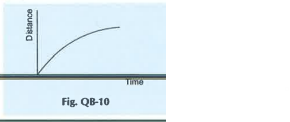If the motion of an object is represented by a straight line parallel to the time axis in a distance-time graph, then the object undergoes
an acceleration motion
a decelerated motion
a uniform non-zero velocity motion
a zero velocity motion
The correct Answer is:D
To solve the question, we need to analyze what it means for the motion of an object to be represented by a straight line parallel to the time axis in a distance-time graph.
1. Understanding the Distance-Time Graph:
- A distance-time graph plots distance (y-axis) against time (x-axis). The slope of the line in this graph represents the velocity of the object.
2. Identifying the Characteristics of the Line:
- If the line is straight and parallel to the time axis, it means that as time progresses, the distance remains constant.
3. Interpreting the Motion:
- A straight line parallel to the time axis indicates that there is no change in distance over time. This means that the object is not moving.
4. Conclusion:
- Therefore, if the motion of an object is represented by a straight line parallel to the time axis in a distance-time graph, the object is at rest.
Final Answer:
The object undergoes rest.
- A distance-time graph plots distance (y-axis) against time (x-axis). The slope of the line in this graph represents the velocity of the object.
- If the line is straight and parallel to the time axis, it means that as time progresses, the distance remains constant.
- A straight line parallel to the time axis indicates that there is no change in distance over time. This means that the object is not moving.
- Therefore, if the motion of an object is represented by a straight line parallel to the time axis in a distance-time graph, the object is at rest.
The object undergoes rest.
Topper's Solved these Questions
Similar Questions
Knowledge Check
Look at the given distance -time graph of an object .
 AThe speed of the object is increasing continuously.BThe speed of the object is decreasing continuously.CThe speed of the object is constant.DThe acceleration of the object is zero.
AThe speed of the object is increasing continuously.BThe speed of the object is decreasing continuously.CThe speed of the object is constant.DThe acceleration of the object is zero.The position-time graph of an object is a straight line parallel to time axis. This implies that the object is
AMoving with uniform accelerationBMoving with uniform velocityCMoving with non-uniform velocityDStationaryThe distance -time graph of an object is a straight line parallel to the time axis , then the object is _____.
Aat restBin uniform motionCmoving with a uniform speedDmoving with a non-uniform speed
What can you say about the motion of an object whose distance-time graph is a straight line parallel to the time axis ?
View SolutionRepresent the motion of an object in unifrom motion along a straight line when both initial distance and velocity of the object is positive .
View SolutionIf the displacement-time graph of a body is a straight line parallel to the time axis, what is the nature of motion of the body?
View SolutionThe distance -time graph of an object is a straight line parallel to the time axis , then the object is _____.
View SolutionThe slope of a distance-time graph of a moving object indicates :
View Solution
